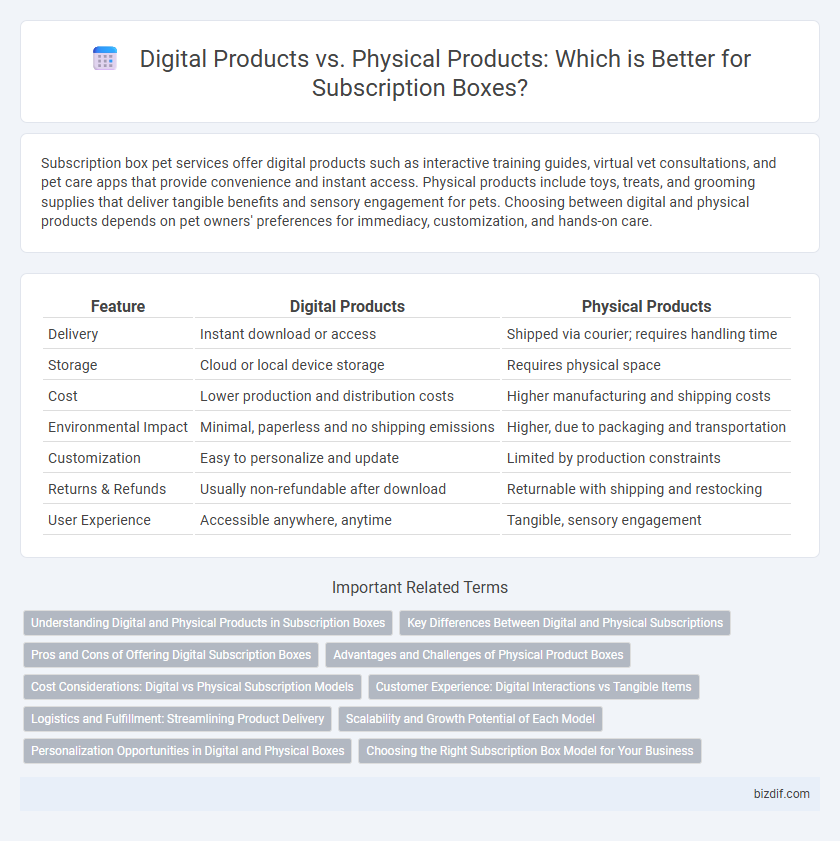Subscription box pet services offer digital products such as interactive training guides, virtual vet consultations, and pet care apps that provide convenience and instant access. Physical products include toys, treats, and grooming supplies that deliver tangible benefits and sensory engagement for pets. Choosing between digital and physical products depends on pet owners' preferences for immediacy, customization, and hands-on care.
Table of Comparison
| Feature | Digital Products | Physical Products |
|---|---|---|
| Delivery | Instant download or access | Shipped via courier; requires handling time |
| Storage | Cloud or local device storage | Requires physical space |
| Cost | Lower production and distribution costs | Higher manufacturing and shipping costs |
| Environmental Impact | Minimal, paperless and no shipping emissions | Higher, due to packaging and transportation |
| Customization | Easy to personalize and update | Limited by production constraints |
| Returns & Refunds | Usually non-refundable after download | Returnable with shipping and restocking |
| User Experience | Accessible anywhere, anytime | Tangible, sensory engagement |
Understanding Digital and Physical Products in Subscription Boxes
Subscription boxes featuring digital products deliver instant access to media files, software, or online courses, offering convenience and no storage requirements. Physical product subscription boxes provide tangible items such as beauty samples, snacks, or apparel, creating a sensory and unboxing experience. Evaluating customer preferences in terms of immediacy, tangibility, and storage needs helps tailor subscription box offerings effectively.
Key Differences Between Digital and Physical Subscriptions
Digital subscription products offer instant access and seamless updates, eliminating shipping delays and storage concerns common in physical subscriptions. Physical subscription products provide tangible items with sensory experiences, often appealing to preferences for unboxing and collecting. Pricing structures differ, with digital subscriptions typically featuring lower production and distribution costs compared to physical boxes that include manufacturing and logistic expenses.
Pros and Cons of Offering Digital Subscription Boxes
Digital subscription boxes offer instant delivery, reduced shipping costs, and eco-friendly benefits compared to physical products, making them attractive for tech-savvy consumers. Their scalability and low overhead enable businesses to reach a global audience without inventory constraints, but they may face challenges in perceived value and customer retention due to the intangible nature of digital goods. Limited sensory experiences and dependency on reliable internet access are notable drawbacks, impacting user engagement and satisfaction compared to traditional physical boxes.
Advantages and Challenges of Physical Product Boxes
Physical subscription boxes offer tangible value through curated items that enhance sensory experience and customer engagement, fostering brand loyalty with personalized packaging and unboxing excitement. Challenges include higher logistics costs, inventory management complexities, and shipping risks like damage or delays, which can impact customer satisfaction and operational efficiency. Despite these obstacles, physical boxes provide memorable, shareable moments that digital products cannot replicate.
Cost Considerations: Digital vs Physical Subscription Models
Digital subscription models often have lower initial costs and negligible shipping expenses compared to physical products, reducing overhead significantly. Physical subscription boxes require inventory management, packaging, and logistics, leading to higher operational costs. Pricing strategies must account for these differences to maintain profitability and customer satisfaction.
Customer Experience: Digital Interactions vs Tangible Items
Digital subscription boxes offer seamless access and instant gratification through downloadable content or streaming services, enhancing user convenience and personalization. Physical subscription boxes provide tactile satisfaction, unboxing excitement, and a tangible connection to curated products that create memorable, multi-sensory experiences. Both formats influence customer experience uniquely, with digital interactions emphasizing speed and adaptability while tangible items foster emotional attachment and physical engagement.
Logistics and Fulfillment: Streamlining Product Delivery
Digital products eliminate complex logistics and inventory management, enabling instant delivery and reducing fulfillment costs. Physical subscription boxes require coordinated warehousing, packaging, and shipping processes, often leading to higher operational expenses and longer delivery times. Streamlining fulfillment for physical products involves optimizing supply chain management and leveraging reliable carriers to ensure timely customer satisfaction.
Scalability and Growth Potential of Each Model
Digital subscription boxes offer unparalleled scalability due to low marginal costs, enabling rapid expansion without inventory constraints. Physical product subscriptions face logistical challenges and higher overhead, limiting scalability but providing tangible customer experiences that can enhance brand loyalty. Growth potential in digital models is amplified by instant delivery and global reach, whereas physical models rely heavily on supply chain efficiency and shipping infrastructure.
Personalization Opportunities in Digital and Physical Boxes
Digital subscription boxes offer extensive personalization through customizable content such as tailored playlists, e-books, or software, enabling instant updates based on user preferences and behavior. Physical subscription boxes provide tangible customization opportunities by including curated items like skincare products, snacks, or apparel, which can be selected according to customer profiles and seasonal trends. Combining both formats enhances user experience by blending interactive digital personalization with the sensory appeal of handpicked physical goods.
Choosing the Right Subscription Box Model for Your Business
Choosing the right subscription box model hinges on understanding customer preferences and operational goals, where digital products offer scalability and instant delivery with minimal overhead costs. Physical products provide tangible value and opportunities for curated experiences, enhancing brand loyalty through sensory engagement and unboxing excitement. Balancing inventory management, shipping logistics, and customer retention strategies helps businesses decide between digital subscriptions and physical product boxes for sustainable growth.
Digital Products vs Physical Products Infographic

 bizdif.com
bizdif.com